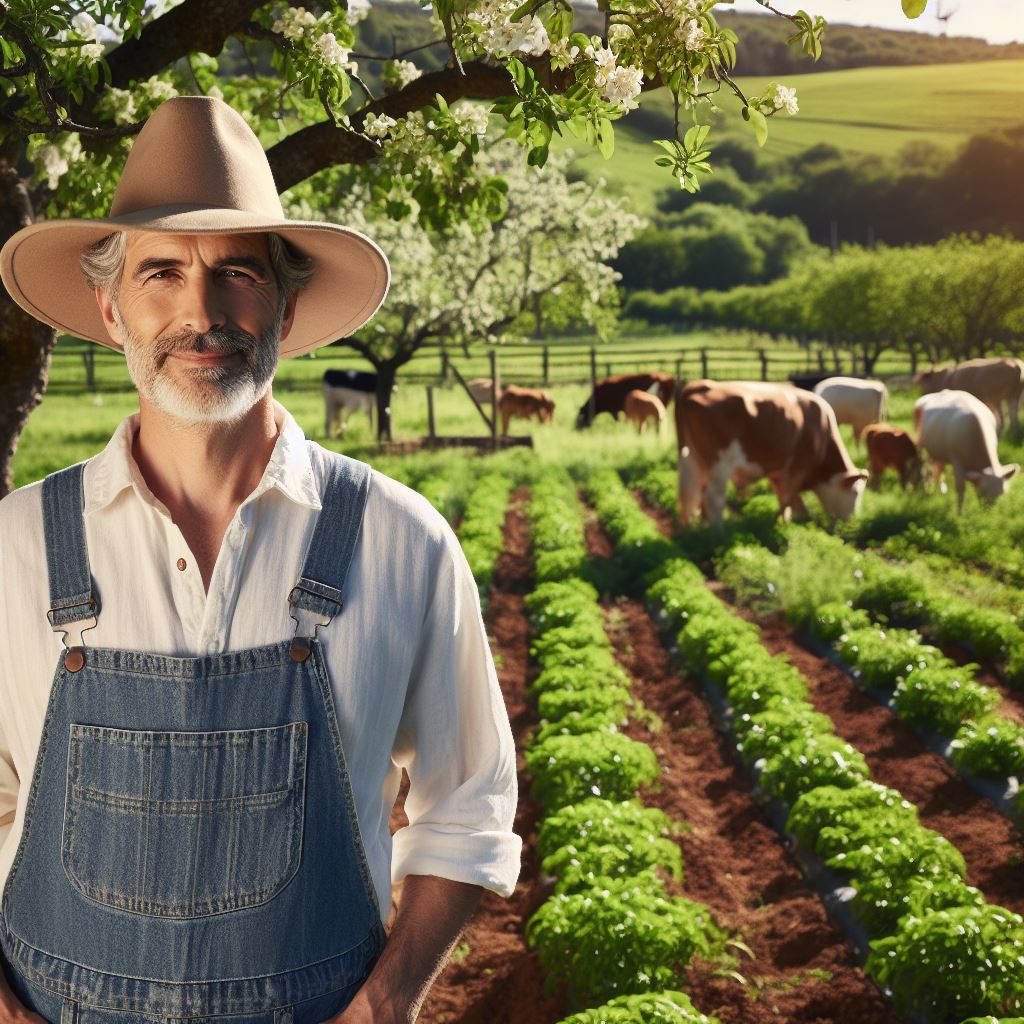Introduction
Agriculture plays a crucial role in our society, but it is facing significant challenges due to climate change.
The concept of climate-smart agriculture addresses these challenges by promoting sustainable farming practices that increase productivity, build resilience, and reduce greenhouse gas emissions.
One such practice that is gaining attention is agroforestry, which integrates trees with crops and/or livestock in the same area.
Agroforestry not only enhances biodiversity but also provides multiple benefits such as improved soil health, increased water retention, and enhanced climate resilience.
Agroforestry is particularly relevant in the context of farming as it helps mitigate climate change by sequestering carbon dioxide from the atmosphere.
The trees planted in agroforestry systems actively absorb CO2, reducing the concentration of this greenhouse gas in the atmosphere.
Furthermore, agroforestry helps farmers adapt to climate change by providing shade and windbreaks, which protect crops from extreme temperatures and strong winds.
The diverse plant species in agroforestry systems also contribute to pest and disease management, reducing the need for chemical pesticides.
In addition to its environmental benefits, agroforestry can also improve farmers’ livelihoods and food security.
By diversifying their income sources through agroforestry products, such as fruits, nuts, and timber, farmers can increase their resilience to market fluctuations and economic shocks.
Overall, agroforestry’s role in farming is vital for ensuring sustainable agriculture in the face of climate change.
By integrating trees and crops, agroforestry supports climate-smart agricultural practices and provides multiple benefits for both the environment and farmers.
Understanding Agroforestry
A. Definition and principles of agroforestry
Agroforestry refers to the practice of integrating trees into agricultural systems. It is a sustainable approach that combines forestry and farming.
The principles of agroforestry involve the strategic placement of trees in farmland to create mutually beneficial relationships between crops and trees.
B. Examples of different agroforestry systems
- Alley Cropping: This system involves planting rows of trees in between rows of crops. The trees provide shade and windbreak, reducing soil erosion and creating a favorable microclimate for crop growth.
- Silvopasture: In this system, trees are combined with pasture or forage crops, allowing livestock to graze while benefiting from the shade and shelter provided by the trees
- Forest Farming: Forest farming integrates agricultural crops with trees that mimic a natural forest ecosystem. It involves the cultivation of shade-tolerant crops like mushrooms, medicinal herbs, and specialty woods.
- Windbreaks: Planting rows of trees along the boundaries of farmland acts as a windbreak, reducing wind speed, and protecting crops from damage. They also prevent soil erosion and provide habitat for beneficial insects and birds.
C. Benefits of incorporating trees in farming practices
- Enhanced soil health: Tree roots penetrate the soil, improving its structure and promoting water infiltration. This enhances soil fertility and reduces the risk of nutrient leaching.
- Biodiversity conservation: Agroforestry systems provide habitat for a variety of flora and fauna, promoting biodiversity and supporting ecological balance.
- Climate change mitigation: Trees absorb carbon dioxide from the atmosphere, acting as carbon sinks. Agroforestry helps reduce greenhouse gas emissions and mitigate climate change.
- Increased productivity: The presence of trees in agroforestry systems provides shade, reducing evaporation and water stress on crops. This leads to increased crop productivity and improved yields.
- Hazard reduction: Agroforestry systems, such as windbreaks, serve as barriers, protecting crops from extreme weather conditions such as strong winds and storms.
- Economic opportunities: Trees in agroforestry systems can provide additional sources of income through the sale of timber, fruits, nuts, and other tree products.
- Water management: Trees help regulate water flow, prevent soil erosion, and improve groundwater recharge. They also act as living filters, reducing the impact of agricultural runoff on water quality.
- Resilience to climate variability: Agroforestry systems are more resilient to climate change impacts such as drought and floods, as the trees provide additional support and protection to crops.
- Cultural and landscape values: Agroforestry systems preserve cultural landscapes and traditional farming practices, enhancing cultural heritage and maintaining aesthetic values.
In short, agroforestry is a sustainable farming practice that integrates trees into agricultural systems.
Transform Your Agribusiness
Unlock your farm's potential with expert advice tailored to your needs. Get actionable steps that drive real results.
Get StartedIt offers numerous benefits, including improved soil health, biodiversity conservation, climate change mitigation, and increased productivity.
By incorporating trees into farming practices, farmers can create resilient and environmentally friendly agricultural systems.
Agroforestry is a valuable tool in addressing the challenges of climate change and ensuring the long-term sustainability of our food production systems.
Read: Trees & Crops: Perfect Pair for Sustainable Farms
The Role of Agroforestry in Climate Resilience
A. Agroforestry’s contribution to climate change mitigation
Agroforestry plays a crucial role in building climate resilience and mitigating climate change impacts.
By adopting agroforestry practices, farmers can contribute to climate change mitigation through carbon sequestration.
Trees planted in agroforestry systems not only absorb carbon dioxide but also combat deforestation and land degradation.
This dual benefit makes agroforestry an effective strategy for reducing greenhouse gas emissions and conserving land resources.
B. Enhancement of biodiversity and ecosystem services through agroforestry
In addition to climate change mitigation, agroforestry enhances biodiversity and ecosystem services.
Agroforestry systems provide diverse habitats that support a wide range of beneficial insects, birds, and other wildlife.
The increased biodiversity improves natural pollination and pest control, reducing the reliance on synthetic fertilizers and pesticides.
Furthermore, agroforestry mimics natural ecosystems, promoting ecological balance, and supporting ecosystem services such as nutrient cycling and water filtration.
C. Improved soil health and water management in agroforestry systems
Agroforestry also offers significant advantages in terms of soil health and water management.
The inclusion of trees in agroforestry systems increases soil organic matter, enhancing soil fertility, structure, and water holding capacity.
Tree roots play a vital role in preventing soil erosion, as they anchor the soil and minimize nutrient runoff.
Additionally, the canopy cover provided by trees reduces water evaporation, conserving water resources in regions prone to drought.
Certain tree species in agroforestry systems have efficient water capture mechanisms, resulting in reduced irrigation requirements.
Agroforestry’s ability to buffer against extreme weather events further protects crops, enhances water infiltration, and improves water retention in the soil.
Overall, agroforestry is a climate-smart approach that integrates trees, crops, and livestock to create sustainable and resilient farming systems.
Its contributions to climate change mitigation, enhancement of biodiversity and ecosystem services, as well as improved soil health and water management, make it a valuable strategy for building climate resilience in agriculture.
By adopting agroforestry practices, farmers can play a significant role in combating climate change while simultaneously reaping the benefits of diversified and sustainable farming systems.
Read: Future Farms: How Agroforestry Shapes Tomorrow
Agroforestry’s Impact on Farm Productivity and Income
A. Higher crop yields and quality in mixed agroforestry systems
- Agroforestry systems promote higher crop yields by providing optimal growing conditions.
- The shade provided by trees in agroforestry systems helps regulate temperature and moisture levels.
- Well-managed agroforestry systems can create microclimates that enhance crop productivity.
- The diverse plant species in agroforestry systems help reduce pest and disease pressure.
- Agroforestry systems improve soil fertility and structure, leading to better nutrient uptake by crops.
- The integration of trees with crops leads to improved soil water retention, reducing irrigation needs.
- Agroforestry systems also contribute to higher crop quality, resulting in increased market value.
B. Economic advantages of diversifying farm income with agroforestry
- Agroforestry allows farmers to diversify their income streams, reducing dependence on a single crop.
- By incorporating trees and diverse crops into their farming practices, farmers can maximize their revenue.
- The additional income from agroforestry products such as timber, fruits, nuts, or medicinal plants boosts profitability.
- Agroforestry products have a higher market demand and value due to their unique qualities and sustainability.
- Diversification through agroforestry provides a safety net against price fluctuations and market uncertainties.
- Agroforestry also creates employment opportunities, benefiting local communities and improving livelihoods.
C. Long-term sustainability and resilience of agroforestry-based farming
- Agroforestry practices help conserve and restore biodiversity by providing habitat for various plant and animal species.
- The integration of trees in farming systems helps prevent soil erosion and protect water quality.
- Agroforestry reduces the need for synthetic inputs such as fertilizers and pesticides, promoting environmental sustainability.
- The shade provided by trees in agroforestry systems reduces heat stress on crops, ensuring resilience to climate change.
- Trees in agroforestry systems act as carbon sinks, mitigating greenhouse gas emissions and combating climate change.
- Agroforestry contributes to the overall ecological balance, promoting long-term sustainability of farming.
In essence, agroforestry plays a crucial role in enhancing farm productivity and income.
It allows for higher crop yields and quality in mixed agroforestry systems through optimized growing conditions and improved soil fertility.
Showcase Your Farming Business
Publish your professional farming services profile on our blog for a one-time fee of $200 and reach a dedicated audience of farmers and agribusiness owners.
Publish Your ProfileDiversifying farm income with agroforestry products provides economic advantages, reduces dependence on a single crop, and creates employment opportunities.
Moreover, agroforestry-based farming ensures long-term sustainability and resilience by conserving biodiversity, protecting soil and water quality, and contributing to climate change mitigation.
Embracing agroforestry practices is essential for farmers to thrive in a changing climate while maintaining profitable and sustainable farming practices.
Read: Agroforestry: A Path to Eco-Friendly Farming
Successful Case Studies and Innovations in Agroforestry
A. Successful agroforestry projects and their achievements
- The Singita Grumeti fund in Tanzania successfully implemented an agroforestry project combining tree planting with sustainable farming practices.
- The project achieved increased biodiversity, improved soil fertility, and enhanced water retention capabilities.
- Farmers involved in the project experienced higher crop yields and improved livelihoods.
- In Brazil, the Mata Atlântica Restoration Pact successfully restored over 24,000 hectares of degraded forest through agroforestry practices.
- The project not only helped in carbon sequestration but also provided habitat for endangered species.
B. Innovative approaches and technologies in agroforestry
- The use of precision agriculture techniques, such as remote sensing and geospatial analysis, to optimize tree planting and intercropping patterns.
- The integration of agroforestry practices with smart irrigation systems, reducing water consumption and increasing crop productivity.
- The adoption of drone technology for monitoring tree growth and health in agroforestry systems.
- The development of mobile applications that provide farmers with real-time information on climate, market prices, and best agroforestry practices.
C. Lessons learned and best practices from agroforestry pioneers
- Agroforestry pioneers emphasize the importance of holistic landscape planning for successful implementation.
- Assessing local ecological conditions and selecting suitable tree species based on site characteristics are crucial for agroforestry success.
- Collaborative efforts involving farmers, scientists, and governmental organizations contribute to the scalability and long-term success of agroforestry projects.
- Training and capacity building programs play a significant role in promoting agroforestry knowledge among farmers and local communities.
- Implementing monitoring and evaluation systems helps track the impact of agroforestry projects and identify areas for improvement.
In general, successful case studies and innovations in agroforestry demonstrate the immense potential of this sustainable farming practice.
Projects like the Singita Grumeti fund in Tanzania and the Mata Atlântica Restoration Pact in Brazil have shown the tangible benefits of agroforestry in enhancing biodiversity, improving soil fertility, and increasing farmers’ income.
Innovative approaches and technologies, such as precision agriculture techniques and smart irrigation systems, further optimize the efficiency and productivity of agroforestry systems.
By incorporating lessons learned and best practices from agroforestry pioneers, we can ensure the long-term success and widespread adoption of this climate-smart farming practice.
Read: Boost Yields: Integrating Forestry with Agriculture

Challenges and Potential Barriers for Agroforestry Adoption
A. Lack of knowledge and awareness among farmers about agroforestry
- Farmers may not have access to information about the benefits and techniques of agroforestry.
- Limited awareness about the potential economic and environmental advantages of agroforestry.
- Lack of understanding about how to integrate trees into their farming practices effectively.
- Insufficient training and educational programs available to farmers on agroforestry methods.
B. Policy and institutional constraints in promoting agroforestry
- Inadequate policies and regulations that incentivize or support agroforestry adoption.
- Lack of coordination among different government agencies responsible for promoting agroforestry.
- Insufficient funding and resources for the implementation of agroforestry initiatives.
- Limited institutional capacity for providing technical assistance and guidance to farmers.
C. Economic and logistical challenges faced by farmers in adopting agroforestry
- Initial investment costs associated with establishing agroforestry systems can be high.
- Uncertainty about the financial returns and long-term profitability of agroforestry.
- Limited access to credit and financing options for farmers interested in agroforestry.
- Lack of markets and value chains for agroforestry products, leading to limited income opportunities.
- Difficulties in sourcing and procuring appropriate tree species and seedlings for planting.
- Challenges in managing and maintaining agroforestry systems, especially for small-scale farmers.
In brief, while agroforestry holds great potential for addressing the challenges of climate change and sustainable agriculture, various barriers hinder its widespread adoption.
Efforts should be made to enhance farmers’ knowledge and awareness, improve policies and institutions, and address economic and logistical challenges to promote agroforestry effectively.
Government and NGO Initiatives to Promote Agroforestry
A. Overview of governmental policies and programs supporting agroforestry
- Governments around the world have recognized the importance of agroforestry in sustainable farming.
- Many countries have implemented specific policies and programs to support and promote agroforestry practices.
- These initiatives aim to enhance environmental sustainability, increase agricultural productivity, and improve livelihoods.
- Governments provide financial support, technical assistance, and training programs to farmers interested in implementing agroforestry systems.
- Incentives such as grants, subsidies, and tax breaks are offered to encourage farmers to adopt agroforestry practices.
- Regulatory frameworks are established to ensure the integration of agroforestry into agricultural land use planning.
B. Role of non-profit organizations and initiatives for agroforestry promotion
- Non-profit organizations (NGOs) play a crucial role in promoting agroforestry globally.
- NGOs collaborate with governments, farmers, and communities to raise awareness about the benefits of agroforestry.
- They provide technical expertise, training, and resources to farmers interested in adopting agroforestry practices.
- NGOs work towards policy advocacy, lobbying for supportive regulations, and funding for agroforestry projects.
- These organizations also facilitate knowledge exchange and create networks among farmers practicing agroforestry.
C. Collaborative efforts for capacity building and knowledge sharing
- Governments and NGOs work together to build the capacity of farmers in agroforestry techniques.
- Training programs are organized to educate farmers about appropriate tree species selection and management practices.
- Collaborative efforts focus on imparting knowledge on sustainable land management, soil conservation, and water resource management.
- Farmer field schools and demonstration plots are established to showcase successful agroforestry models.
- These collaborative initiatives help bridge the gap between research and implementation, ensuring effective adoption of agroforestry practices.
- Knowledge sharing platforms, workshops, and conferences are organized to encourage exchange of experiences and best practices.
- Governments and NGOs develop and disseminate educational materials, guidelines, and manuals on agroforestry.
- Information and communication technologies are utilized to reach a wider audience and facilitate knowledge sharing on agroforestry.
In a nutshell, both governmental and non-profit initiatives play a crucial role in promoting agroforestry.
These initiatives focus on policy support, financial assistance, capacity building, and knowledge sharing to enable the adoption of climate-smart agroforestry practices.
By working together, governments and NGOs can create an enabling environment for sustainable agricultural practices, benefiting both farmers and the environment.
Conclusion
Agroforestry offers numerous advantages in terms of climate resilience, soil health, biodiversity conservation, and income diversification.
By integrating trees into agricultural systems, farmers can enhance their yields, mitigate climate change, and achieve sustainable productivity.
Farmers should seize the opportunity to adopt agroforestry practices, while policymakers need to create enabling policies and financial incentives.
All stakeholders must collaborate to provide technical support, training, and access to resources for the successful implementation of agroforestry.
Agroforestry holds immense potential in addressing the challenges of climate change and food security.
As awareness grows and knowledge is shared, agroforestry has the capacity to become a mainstream farming practice.
Its ability to sequester carbon, conserve water, and enhance biodiversity makes it a crucial tool in achieving sustainable agriculture.
Agroforestry is a climate-smart approach that offers multiple benefits to farmers, ecosystems, and societies.
By embracing agroforestry, we can create a more resilient and sustainable future for agriculture.




